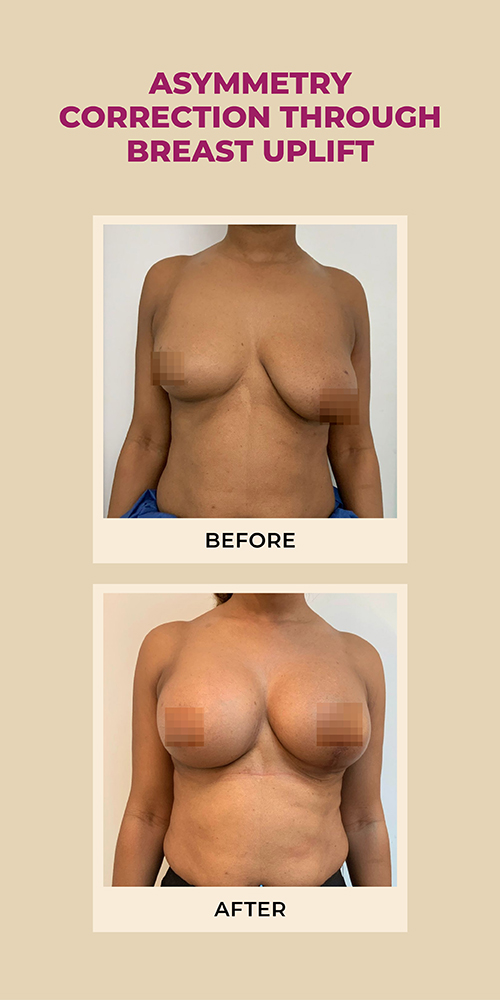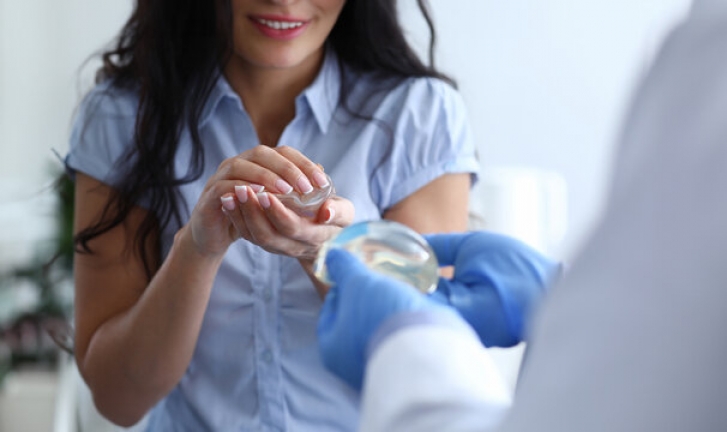
If you’ve been trying to understand the difference between breast augmentation and breast uplift, then you’ve come to the right place.
Already know which surgery you want? Talk to our doctors at Sunion Health to understand how your breast surgery is customised for your body and objectives.
Whether you’re looking to add some volume to that hourglass figure or simply just lift things back to their rightful place, breast surgeries like augmentation and uplift are all about turning those dreams into reality.
And you’re not alone! Breast augmentation and breast uplift are two extremely popular cosmetic procedures in the UK. Breast augmentation takes the crown, with an impressive 6,640 women choosing it each year. Not far behind is the breast uplift, with around 5,270 women opting for this confidence-booster, especially those looking to get back their pre-baby body.
What is a Breast Uplift?
Also known as a mastopexy, a breast uplift is a surgical procedure, which specifically alters the shape and position of your breasts. It’s very important to understand that a breast lift does exactly that. It lifts the breasts back to their original position and unlike augmentation, does not increase the volume.
The excess skin is removed and the tissue is tightened by the surgeon. This helps to restore breasts to a more youthful position – something that may have been impacted by life changes such as weight loss, ageing, breast-feeding etc.
Who’s an Ideal Candidate for Breast Uplift?
Breast uplifts or breast lifts are a popular choice with women in their 30s to 50s, who are happy with their breast size but who may have experienced significant life changes that affected their breasts. Often, we see women who lose a lot of weight and experience a sagginess of their bust with the reduction of fat tissue. They may seek a correction in breast position through a breast uplift.
Mothers who have breastfed can also experience the same condition due to stretching and shrinking of breast tissue over their pregnancy and delivery. And then there are women who are entering or past middle age and seek to counteract some of the natural effects of gravity and ageing.
In all the above cases, a breast uplift could be the ideal solution to help women reclaim their figure and confidence.
Why Choose a Breast Uplift
- Increase in Firmness: The mastopexy procedure will tighten the breast tissue, giving your breasts a firmer and more youthful look.
- Natural Appearance: Since breast lifts do not involve implants, the results blend well with your natural body shape.
- Improvement in Shape: Breast uplifts control sagging and drooping, restoring a more youthful look to your breasts.
- Boost in Confidence: Most women experience improved self-esteem and confidence with appearance after the procedure.
 Procedure for a Breast Uplift
Procedure for a Breast Uplift
This procedure is usually done under general anaesthesia. Local anaesthesia is also given so that people wake up without pain or with reduced pain.
The exact technique used for a breast lift varies based on how much repositioning is required. This is obviously based on each person’s individual body shape and size.
During the procedure, the surgeon will make incisions around the nipple which will sometimes extend down to the lower part of the breast. Excess loose skin is then removed and the nipple is positioned higher on the torso. After this is done, the surgeon may reshape your breast tissue to ensure your breasts are symmetrical and proportionate to your body.
Healing from a Breast Uplift
You’ll likely be up and running with your daily routine in about a week and back to work in 1 to 2 weeks, depending on your job. In the beginning, you might have swelling, bruising, and some discomfort, but these will get better as you heal.
The full results become visible once the swelling goes down, which typically takes a few months. To help your recovery along, it is important to closely follow your surgeon’s advice and give yourself the time you need to heal. With a little patience, you’ll soon be enjoying the perkier figure you’ve been dreaming of!
Though the breast uplift surgery gives you a firmer and more youthful look, it is important to keep in mind that it doesn’t add volume or change your cup size; for that, you would need breast augmentation with implants.
What is Breast Augmentation?
Breast augmentation (often known as breast implant surgery or more commonly, a boob job) is a cosmetic procedure designed to enhance the size, shape, and volume of the breasts, improve symmetry, and give your breasts a more balanced appearance.
This is commonly done placing silicone implants. Recently, though, breast augmentation with fat transfer procedures have been gaining popularity as a less invasive, natural alternative to implants. Fat transfer involves using liposuction on another part of your body with excess fat tissue, and processing the same before implanting your pure body fat back into your breasts. Which means, of course, that there are no implants necessary.
Who’s an Ideal Candidate for Breast Augmentation?
Breast augmentation is suitable for women who wish to increase their breast size while improving breast shape and volume. This may include women who want to correct a noticeable difference in the size or shape of their breasts.
NOTE: The ideal breast augmentation candidate should be in good health and should have no medical conditions that might affect the healing process. There is also the age factor to keep in mind: You need to be at least 18 years or older to consider this procedure.
Why go for a Breast Augmentation?
Aesthetics: Some women desire a fuller bust or may have issues with asymmetrical breasts. Breast augmentation can resolve this problem easily.
Surgery or Injury: Breast augmentation may be one of the reconstructive surgeries available to women who have undergone mastectomy or experienced physical trauma. Since this is considered to be a plastic surgery rather than a cosmetic surgery, it would be available on the NHS.
Procedure for a Breast Augmentation
This procedure may be done under general anaesthesia or deep sedation along with local anaesthesia. The surgical process for a breast augmentation procedure begins with an incision either a) within the crease under the breast, b) around the areola or c) inside the armpit. This decision is based on factors such as your body, the type of implant and the desired final size you are looking for. It’s important to understand how this procedure will go during your initial breast surgery consultation.
The surgeon will insert your chosen implant into the pocket created either in front of or behind the chest muscle. This too, is dependent on the patient’s body and their desired outcome and will be explained to you in detail prior to surgery.
Healing after Breast Augmentation
A boob job is a surgical procedure and it is to be expected that your recovery will be similar to any other invasive surgery. Be mentally prepared for a recovery period of around 6 to 8 weeks, during which time you will need more rest and have to limit your activities. The early days after your surgery, you can experience some swelling and bruising, but as healing occurs, these symptoms will minimise. Once the swelling subsides, your surgeon and clinic assistant will guide you through the post-surgery procedures and schedule follow-up visits to manage your dressing. In time, your new boobs will settle, and you can look forward to enjoying your brand new look within a few months.
Breast Uplift vs. Breast Augmentation
| Breast Uplift (Mastopexy) | Breast Augmentation | |
| Purpose | To reposition sagging breasts without increase in volume. | To increase breast size, shape, and volume through implants. |
| Procedure | Excess skin is removed, and existing breast tissue is repositioned. | Implants (silicone or saline) are inserted to enhance size or body fat is transferred. |
| Ideal Candidates | Women desiring to restore breast firmness and address sagging. | Women seeking to enhance breast volume, shape, or correct asymmetry. |
| Volume Enhancement | Does not increase volume; focuses on lifting and tightening. | Provides significant volume increase and a fuller appearance. |
| Invasiveness | Involves removal of excess skin and repositioning of breast tissue. | Involves insertion of implants through incisions. |
| Scarring | Scarring around the areola, and sometimes extending vertically or along the breast crease. | Scarring around the implant site, typically along the breast crease, areola, or armpit. |
| Recovery Time | Around 2 to 4 weeks to resume schedule, and a couple of months for bruising and swelling to fade; some may experience discomfort. | 6 to 8 weeks recovery. Swelling and bruising in the breasts before healing begins. |
| Expected Results | Firmer, perkier breasts with a more youthful appearance. | Fuller, rounder breasts with enhanced volume and improved symmetry. |
| Impact on Cup Size | No change in cup size; focuses on breast shape and lift. | Increases cup size depending on implant size. |
| Longevity of Results | Results can be long-lasting, but may change with age, weight fluctuations, or pregnancies. | Results can last for several years, with the possibility of needing replacement implants. |
| Post-Procedure Care | Involves monitoring of the healing of incisions and overall breast shape. | Requires careful monitoring of implant placement |
The Breast Augmentation + Breast Uplift Combo
If you want to enhance both the size and shape of your breasts while tackling sagging, this combined procedure might be a great choice. It provides you with a one-stop solution by giving you fuller, firmer, and more youthful-looking breasts.
To find out if a combined procedure is right for you, talk to a qualified surgeon. They will be able to understand what you hope to achieve with this procedure and whether or not it will meet your specific needs.
What to Keep in Mind When Choosing a Combo Procedure
To know whether a combined breast augmentation and uplift is the right choice for you, the following factors need to be considered:
Post-Pregnancy Changes: As pregnancy and breastfeeding change the breast shape and volume tremendously, women who’ve already had children often see the greatest benefits from combining these procedures. By combining augmentation and a lift, you can help restore both the fullness and firmness that may have been lost, giving you back a more youthful and balanced look.
Sagging and Volume Loss: If you’ve noticed both sagging and decrease in breast volume, a combined breast augmentation and breast uplift surgery might be right for you.
Breast Augmentation and Breast Uplift: The Benefits
- Single Recovery Period: A huge benefit of having both procedures done at the same time is that you only have to go through one recovery period. Compared to having each surgery done separately, this means less time off work, childcare, or other personal responsibilities.
- Well-rounded Results: This combined procedure tackles several concerns in one go. It delivers well-rounded results—no pun intended—by creating a more balanced and harmonious appearance. It effectively addresses both sagging and volume loss, giving you a cohesive and flattering look.
- Less Expensive: When both procedures are done simultaneously, you typically pay only one set of surgical fees, including operating room costs and anaesthesia fees. If performed separately, each procedure would incur separate fees.
Frequently Asked Questions (FAQs)
What are the potential risks and complications of breast surgery?
Some other potential risks to keep in mind are changes in nipple sensitivity, infections and scarring. Sometimes, breast augmentation can result in implant-related issues. With breast uplifts, concerns could involve changes in breast shape over time.
How do I prepare for a breast augmentation or uplift procedure?
Start by having a consultation with your surgeon about your goals. Remember to follow all their preoperative instructions and make sure you arrange for some help during your recovery period.
At Sunion Health, our patient advisor will also be available to you throughout the process – to address all your pre-op concerns, to guide you through the procedure, and to make sure you get the required help during your recovery period.
Will my breasts look natural after these procedures?
Yes, because your surgeon’s goal is to achieve natural-looking results that work well with the rest of your proportions. Make sure you discuss your expectations during your initial consultation. You can even show your surgeon any pictures that help to visualise your preferred look better, and together with your surgeon, you can settle on the size, shape, and implants that help you achieve the natural look that you are going for.
What changes do I have to make to my life before or after the surgery?
You may be advised to manage your weight, cut down on alcohol consumption, or stop smoking in the days prior to the surgery. This is to help you heal better after the procedure.
After the surgery, promptly follow your surgeon’s post-operative care instructions. Take at least 10 days off from work to get as much rest and recovery time as possible. Take it easy for a few weeks more, avoiding activities where you have to exert yourself, maintain a healthy diet, wear the supportive bra that you have been prescribed, and don’t miss any scheduled wound care appointments.
Will a breast augmentation and lift procedure impact any future pregnancies or my ability to breastfeed?
While these procedures won’t impact a future pregnancy, a future pregnancy might affect the aesthetic results you’ve achieved, and you might want a second procedure to restore the results of your original surgery.
Most women who have undergone breast lifts or augmentation can breastfeed their infants either fully or partially, but in rare cases a breast surgery may significantly impact lactation.
In short, physical and hormonal changes during pregnancy and the breastfeeding process are natural, which is why many women opt to wait till their final pregnancy before getting these procedures. Ultimately, it’s all about your personal preferences, and we recommend you discuss your options with your surgeon and a lactation consultant and weigh the benefits and risks carefully before committing to any cosmetic breast surgery.
How much do breast augmentation and breast uplift procedures cost?
The costs of these procedures can differ based on different elements like the procedure type, surgeon charges, and location. Discussing pricing and payment options with your clinic is best.
At Sunion Health, our prices start at £3995 for breast augmentation surgery, £5495 for a breast uplift surgery and £5995 for a combined augmentation and uplift. Implants will be charged extra depending on the size, type, and brand of implant you choose, so be sure to discuss your options with your surgeon.
What should I look for in a qualified surgeon?
Ensure that your surgeon is registered with the General Medical Council on their specialist register and has a licence to practise. Opt for a surgeon who has prior experience in breast surgeries, positive patient reviews, and a good track record of successful procedures. Come prepared to your first consultation with questions so that the process is clear to you.
Finding Your Perfect Fit: Breast Augmentation or Uplift?
As with any other medical procedure, the first consideration is to ensure that you’re fit and healthy to undergo surgery. Women with high BMIs are often referred to their GP to ensure their condition does not negatively impact their health.
Next, take the time to consider your shape and body goals.
Start by thinking about what you want to achieve—whether it’s adding volume, combating sagging, or both. If you’re dealing with a loss of volume and sagging, a combined approach might be your best bet.
When ready to take the step, meet with a qualified surgeon and discuss the procedure. Your surgeon may have an alternate view, which is important for you to consider.
Finally, remember that your body is unique, and your results should be designed to make you comfortable and confident. So take the time to understand every step before choosing your procedure.









